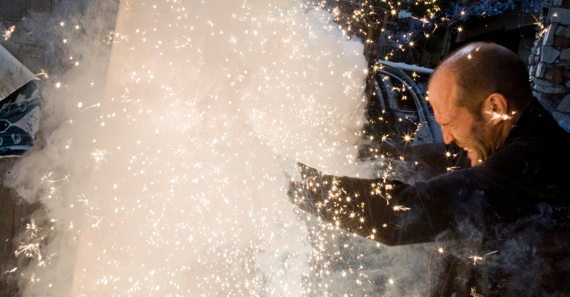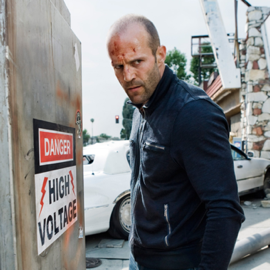 What do a grip of prosumer HD cameras, a high voltage film star, and a greenlight to follow up a successful action film have in common? They all converged to produce, “Crank 2: High Voltage” which quickened audience’s heart rate’s April 17th. Re-recording mixers Joe Dzuban and Bob Beemer set up shop at Todd-AO’s Hollywood local while Sounddelux’s Scott Martin Gershin served as supervising sound editor. With greater Los Angeles as its backdrop, “Crank 2’s” location sound was mixed by Robert Sharman the only sound department carry over from the first film. Going in a bold new direction, directors Mark Neveldine and Brian Taylor tapped Hard Rock Avant-garde musician Mike Patton to score the film who comments on his work in the video below.
What do a grip of prosumer HD cameras, a high voltage film star, and a greenlight to follow up a successful action film have in common? They all converged to produce, “Crank 2: High Voltage” which quickened audience’s heart rate’s April 17th. Re-recording mixers Joe Dzuban and Bob Beemer set up shop at Todd-AO’s Hollywood local while Sounddelux’s Scott Martin Gershin served as supervising sound editor. With greater Los Angeles as its backdrop, “Crank 2’s” location sound was mixed by Robert Sharman the only sound department carry over from the first film. Going in a bold new direction, directors Mark Neveldine and Brian Taylor tapped Hard Rock Avant-garde musician Mike Patton to score the film who comments on his work in the video below.
I wanted to thank production mixer Robert Sharman for putting up with my work schedule and still delivering this great Q and A.
Designing Sound: This month’s American Cinematographer quoted your DP Brandon Trost with prepping sometimes 100 set-ups a day, “There was an improvisational vibe on the set,” Taylor enthuses. How did this translate to your job? What was one of the most challenging set ups?
Robert Sharman: Getting quality sound with no rehearsals and three cameras pointing in every direction at any time was a real challenge. More than 90% of the time I was unable to see what was happening. We had no video wired or transmitted from the cameras, and due to the fact that most sets were 360 degrees., I was always blind to what the action was. This made mixing on set challenging, since part of the art of mixing is knowing what mics (combination of lavs and boom) to bring up on the mix and when. Seeing the physical relationship of where the actors and cameras are is very important when using such non-traditional shooting techniques. It’s especially important on an action movie where one actor might be doing some movement that creates noise on his lav, and using another nearby actor’s lav or boom might be better. I didn’t have this luxury.
I relied heavily on my boom operator, Rich Bullock, to communicate after each take what was happening in the scene, and how things were changing after each take. He was able to stay out of shots by hugging the back of the director/operators. Even at times when he was unable to boom a scene, he was there to communicate with me after takes, as well as being there to keep an eye on the actors’ wireless mics. It was a critical relationship, and I can’t thank him enough for his contribution.
I also had to rely on knowing that the dialog editors and mixers in post would be able to piece together my work. It was important to get them a production track with all levels and “perspective” equal for all takes regardless of changes in action or camera position. I used a multi-track recorder to keep all actors on their own isolated tracks so post could use my mix or create their own from the isolated tracks. Typically, on a traditional film, a production mixer likes to use a combination of techniques to match the perspective of sound to that of the camera. We feel the location and have an organic sense of each scene and of the film as a whole. I believe this really translates to a greater sense of reality for the audience, and I like to capture that on all of my production tracks. In this case, however, that was something I was comfortable foregoing in lieu of getting the highest percentage of usable dialog in a very short production schedule. Shooting a big action movie in 32 days is not easy!!
Almost every set up was challenging. We had VERY noisy locations and picture vehicles and stunt vehicles and police Harleys all the time. But probably the hardest set up to get usable sound was one of our only indoor locations, the strip club. Lots of guns and action and dialog in the same takes, and the location was mostly unboomable due to lighting and camera positions. We could not put lavs on Amy or Bai Ling due to “wardrobe restrictions”, and there was shoving between Jason and Corey. It was also day 2 of the schedule, so we were all still feeling things out.
DS: With working on the first “Crank” was there anything you got an opportunity to fix and or avoid for the sequel?
RS: Every film is different, including each of the “Crank” movies. About the only advantage of having worked on the first “Crank”, was knowing to some degree what to expect from Neveldine/Taylor. The first “Crank” used only two cameras mostly and sometimes just one. The main cameras were either tethered to a monitor for HD purposes (more necessary a few years ago), or the large HD deck was strapped to Neveldine’s back, seriously slowing him down. It somehow seemed a little more “controlled” than the second one, but not in a filmmaking sense, just in a restrictive equipment sense. But I must confess, not having mixed the first one, my friend Steve Morrow might tell a different story from his perspective. Both films were very hard from a physical standpoint, but were so much fun to do, that I don’t remember any mental anguish in hindsight. To use a silly analogy, it’s much like why I suspect women have more than one child…they just don’t remember the pain part of the birth, only the joy.
FSD: “No one is more acutely aware of what a collaborative art filmmaking is than
a member of the sound department,” stated Production mixer Mark Weingarten in Coffey Sound’s latest newsletter. During production how did other departments collaborate with you? Were there any situations where you had to otherwise comprise your track to location, lighting, camera, catering, etc.?
DS: Typically Mark’s quote is very true, but “Crank: High Voltage” was not typical in any sense of the word. It was collaborative in that we all had to do our jobs to get the project done. It
was not collaborative in the sense that we worked together, like a crew might do on a more traditional film. I don’t mean this in a bad way. We were a very close crew. We all got along. But we were there to bring to the screen what Mark and Brian decided to shoot that day, their vision. The crew on a film like this needs to rely on their own expertise, and we simply didn’t have the time to “plan” how to help each other. We all had to think on our feet and react to the constant change.
There was constant compromise in every department, but we knew that “Crank” is more about the experience in the theater, and less about the small details. Mark and Brian used to joke that you can’t bring your ’A’ game to “Crank”, or you’ll just be in the way. The reality is that we just had to bring a different kind of ‘A’ game.
DS: Sometimes in post we feel like we are victims of our own technology as in the faster and more efficient we work, the less time producers give us to do that work. Is that theory the same on set and how do you guys adapt to it?
RS: It’s exactly the same for production. Shooting schedules have become shorter. “Crank” and “Crank: High Voltage” were shot in 30 and 32 days. Editing styles have something to do with this. With less time per edit for the audience to “notice” things, the small details are forgotten. “Crank” is a feeling, a ride, pure fun. Details matter less.
While I wouldn’t say this about many films, sometimes sacrificing the details to get a movie made is completely worth it. The “Crank” movies ARE worth it.
DS: How has the adoption of video in the past couple of years changed the way production mixers work? Did it affect you at all on this show?
RS: Using more cameras to shoot a scene is the greatest detriment to a quality sound track. The lower cost of video cameras makes using more cameras easy. And now, with file-based systems making recording media and media storage cheap, and being able to achieve a high quality image from prosumer cameras, multiple-camera shoots are the norm. Shooting wide and tight shots at the same time eliminates the use of techniques to match sound perspective to picture perspective. Cross coverage with multiple cameras limits traditional lighting techniques that make booming a scene possible. When you watch an older film, a wide shot might have an actor in the background talking and appropriately he sounds like he is where he is. These days, an “extra” camera on set might use a long lens to grab his close-up at the same time.
A boom mic creates a much higher quality recording than a lav, but we are forced to compromise quality to accommodate shooting wide and tight coverage simultaneously. The audience these days has become used to the absence of perspective sound, so often we find no alliance in any department, including the director or producer. Often we must simply “get the words” without slowing down production. If we are able to get it right, then that’s a bonus. I try to get it right on EVERY project, so it can be very disheartening when I simply can’t. I must confess that when I am hired on a small movie shooting on film, and they can’t afford to shoot with two cameras, I get very excited. I may only be 40 years old, but I love old-school filmmaking.
DS: What was your first gig like?
RS: I have bounced around a bit in terms of jobs in the films business. My very first film job was as Pauly Shore’s stand-in and assistant on “Encino Man”. As a kid just out of college, this was the greatest job ever. The sound mixer on that job, Robert Wald, is still a friend to this day. But I soon discovered I liked being a technician.
Eventually it came to be that I started mixing, and now feel I have finally found the job I love. It’s a perfect blend of technical knowledge and artistic contribution. And I get paid for it!
My first film or two as a mixer were “painful” to say the least. I have never seen the first one, for a number of reasons. The second one was a combination of some poor production sound and post-production sound. I felt I was ready, so I wasn’t nervous, but I definitely made mistakes. Part of it came from my lack of experience, and part of it came from the production not being able to afford for me to hire an experienced boom operator. Having experienced “guys” (women included) in my department makes the job easier and the quality of my sound better. From that point on, I have to say I am proud of my work in general, including that on “Crank: High Voltage”.


Thank you for your hard work. I Love it! And it is very interesting!